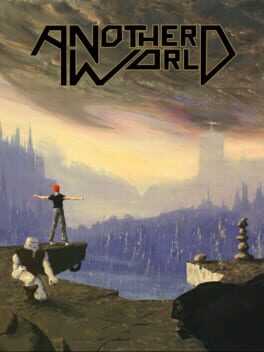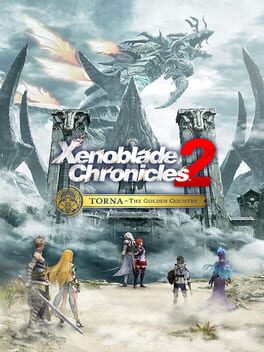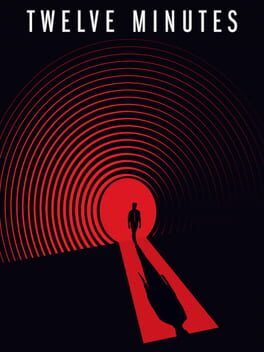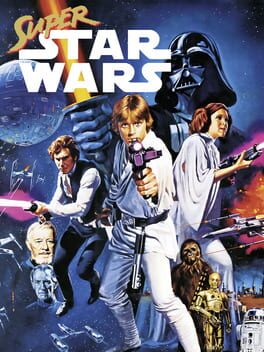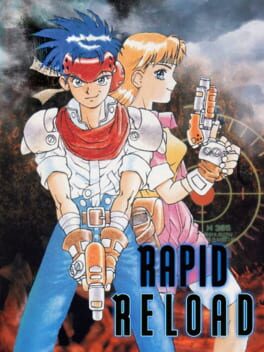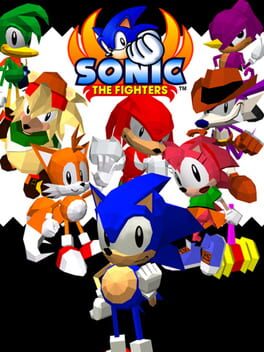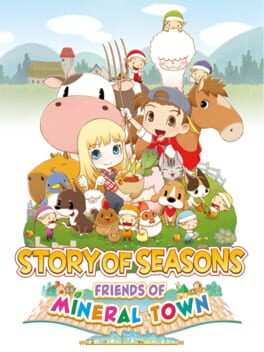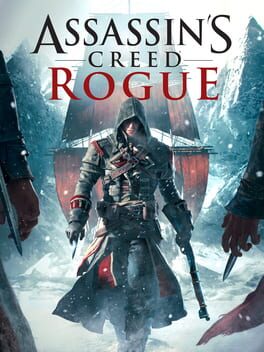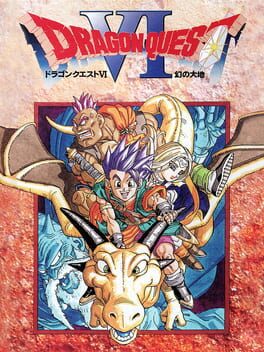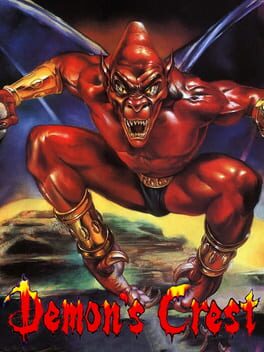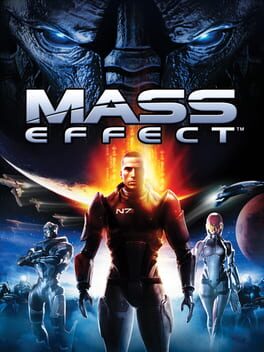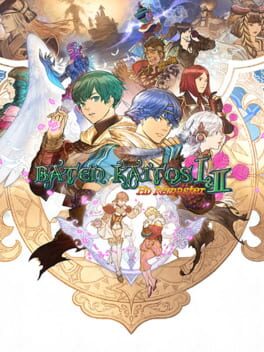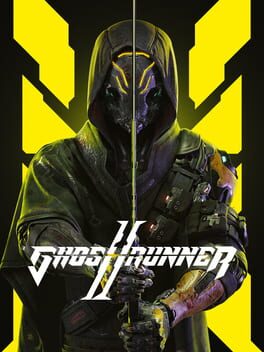EvilPhimie
64 reviews liked by EvilPhimie
Halo 3
2007
Another World
1991
One of the most beautiful and daunting games of all time. It's also an unfair, annoying, cryptic mess. Many will let it off just because of how stunning it is to behold, but this isn't a fucking art gallery, is it?
I will give it credit though, since it was mostly made by 1 man. That must been a Herculean scale task. I would still recommend trying it out, but don't come in expecting the greatest game ever made or something.
I will give it credit though, since it was mostly made by 1 man. That must been a Herculean scale task. I would still recommend trying it out, but don't come in expecting the greatest game ever made or something.
A more refined Xenoblade 2 experience that I wish was of similar scope to the mainline games that ultimately ends up tripping itself by asking the bold question “what if we made 6+ hours worth of optional content mandatory at the eleventh hour?”.
I fully get from a ludonarrative standpoint asto why they made side quests a crucial element of the writing, but given the urgency of the story at that point, that’s not something that should suddenly be of importance to get to the end and I wish that element was incorporated into the game in a way that doesn’t outright kill its momentum in order to inflate playtime. Still a more consistent experience compared to the base game and a good time with some great OSTs, but it did leave me wanting more out of what we got with its characters and writing.
I fully get from a ludonarrative standpoint asto why they made side quests a crucial element of the writing, but given the urgency of the story at that point, that’s not something that should suddenly be of importance to get to the end and I wish that element was incorporated into the game in a way that doesn’t outright kill its momentum in order to inflate playtime. Still a more consistent experience compared to the base game and a good time with some great OSTs, but it did leave me wanting more out of what we got with its characters and writing.
Twelve Minutes
2021
Within the first 5 seconds of freedom this game gave me, I immediately picked up the kitchen knife and used it in probably the worst way possible. The game didn’t stop me and it also didn't seem to care, and neither did I. But that was probably the worst way possible to start this game, because as it dragged on for hours the main thought in my head was, “We were cooking on the first route” which should have ended the game. Instead I was trapped in a torture chamber of nonsensical solutions and horrible dialogue delivery, with an ending that wasn’t even interesting enough to be worth the painful drawl. The image of Daisy Ridley’s weird polygonal feet are scarred into my brain forever.
While I find the trial and error bit of gameplay to be rather neat, it’s done in such an excruciatingly painful way here. Every do-over lacks the ability to skip the cinematics so you’ll feel your body rapidly age with every scene you’re forced to watch on repeat. The lack of options your character gets to work with are frustrating and unrealistic. The characters shamble around like zombies and there’s zero way to speed up the process to get back to a later segment in the timeline aside from some line skips. I guess had they implemented such a silly concept then the game would quite literally be 12 minutes long. Instead, you sit through hours of trying out the smallest changes, only to awkwardly miss-click something and have to redo the whole process again. With every make-out session your wife assaults you with unprompted at the beginning of every loop, the more reptilian I felt while playing this game. How icky it made me feel while I slowly became an iguana.
You’d think a game that allows you to stab the shit out of your wife in the first five seconds would have literally anything to say about violence or impatience or domestic abuse or literally anything? Maybe it’d point a finger at me and go, “You’re part of the problem!!” and question my immediate conclusion to stretch the game's choices to it’s most inhumane limits. Nope. It meant nothing, like it was just something cool you could do for the sake of it. Violence is actually the only way to siphon any useful information from any of the characters, in fact the peaceful communicative solutions don’t even open up until after you’ve murdered so it’s not like it’s not encouraged. But, it literally doesn’t acknowledge this as something awful nor does it affect your character in any real way. The game does not care, so why should you? Allowing me to start the game with the ability to do this really set itself up for failure. It never challenged my thought process, so I just simply progressed with not giving a shit. It's almost like game interactivity has a way of affecting the player if it's implemented in a meaningful way instead of just existing for "artistic" shock value.
At the end of the day, does it even matter? I went through all this effort just to land on a conclusion that I said out loud as a joke. When the twist happened and that joke ended up being the reality, oh fuck off. This is it. It’s just a game that let me murder my wife in the first 5 seconds of it and nothing else. Riveting stuff, guys.
How they got James McAvoy, Willem Dafoe, and Daisy Ridley involved in this is insanely hilarious. They sound like they’re phoning it in the whole time, like they don’t even believe in this game’s bullshit themselves. It’s artistic, I’ll give it that. But, am I buying it? No. I ate chocolate mousse while a man screamed at my wife and hogtied her to the floor right in front of me. Neat.
While I find the trial and error bit of gameplay to be rather neat, it’s done in such an excruciatingly painful way here. Every do-over lacks the ability to skip the cinematics so you’ll feel your body rapidly age with every scene you’re forced to watch on repeat. The lack of options your character gets to work with are frustrating and unrealistic. The characters shamble around like zombies and there’s zero way to speed up the process to get back to a later segment in the timeline aside from some line skips. I guess had they implemented such a silly concept then the game would quite literally be 12 minutes long. Instead, you sit through hours of trying out the smallest changes, only to awkwardly miss-click something and have to redo the whole process again. With every make-out session your wife assaults you with unprompted at the beginning of every loop, the more reptilian I felt while playing this game. How icky it made me feel while I slowly became an iguana.
You’d think a game that allows you to stab the shit out of your wife in the first five seconds would have literally anything to say about violence or impatience or domestic abuse or literally anything? Maybe it’d point a finger at me and go, “You’re part of the problem!!” and question my immediate conclusion to stretch the game's choices to it’s most inhumane limits. Nope. It meant nothing, like it was just something cool you could do for the sake of it. Violence is actually the only way to siphon any useful information from any of the characters, in fact the peaceful communicative solutions don’t even open up until after you’ve murdered so it’s not like it’s not encouraged. But, it literally doesn’t acknowledge this as something awful nor does it affect your character in any real way. The game does not care, so why should you? Allowing me to start the game with the ability to do this really set itself up for failure. It never challenged my thought process, so I just simply progressed with not giving a shit. It's almost like game interactivity has a way of affecting the player if it's implemented in a meaningful way instead of just existing for "artistic" shock value.
At the end of the day, does it even matter? I went through all this effort just to land on a conclusion that I said out loud as a joke. When the twist happened and that joke ended up being the reality, oh fuck off. This is it. It’s just a game that let me murder my wife in the first 5 seconds of it and nothing else. Riveting stuff, guys.
How they got James McAvoy, Willem Dafoe, and Daisy Ridley involved in this is insanely hilarious. They sound like they’re phoning it in the whole time, like they don’t even believe in this game’s bullshit themselves. It’s artistic, I’ll give it that. But, am I buying it? No. I ate chocolate mousse while a man screamed at my wife and hogtied her to the floor right in front of me. Neat.
Super Star Wars
1992
Ah, man. Really not as good as I remember. Still too hard for its own good, which I had already been well aware of, but it also just feels like a very blah experience past that. It spends 75% of its time on Tatooine, and while A New Hope certainly does more than enough to get by with only two or three main locations, it feels unvaried and kind of shit when padded out to 12 stages. Around the second half of the game you get the option to play as Han or Chewbacca, but there's never really any reason to play as Han since Luke retains his blaster after receiving his lightsaber anyways, and Chewbacca plays poorly and doesn't really feel suited to his surroundings. Also around this point, many levels seem to use the same song in a row and it gets really grating. One of my friends ended up just muting the stream until it was over, and honestly I can't blame him.
It's really only the graphics and presentation that shine here in retrospect, and everything else needs a bit of work. Having to pull teeth to complete the game even on Easy isn't really worth it when there's already not as much to appreciate. The sequels are a little more varied if my memory serves me well, but even harder. I don't even know if I can endure them again.
It's really only the graphics and presentation that shine here in retrospect, and everything else needs a bit of work. Having to pull teeth to complete the game even on Easy isn't really worth it when there's already not as much to appreciate. The sequels are a little more varied if my memory serves me well, but even harder. I don't even know if I can endure them again.
Pikmin
2001
The secret behind Pikmin’s success was not that it somehow outclassed classic real-time strategy franchises, but rather that it was never competing with them to begin with. According to Shigeru Miyamoto, he came up with the idea for Pikmin one day when he observed a group of ants carrying leaves together into their nest. Miyamoto then imagined a game focused on cooperation rather than competition; he asked, “Why can’t everyone just move together in the same direction, carrying things as a team?” Nintendo EAD’s design philosophy went along with this line of reasoning, melding design mechanics from different genres to create an entirely new yet familiar experience. As a result, instead of competing against other players in Pikmin akin to classic RTS games, Pikmin forces players to explore and compete with the very environment itself by introducing puzzle-exploration and survival mechanics. It made sense in the end; after all, real-time strategy is concerned with minimizing time spent to get a competitive edge over opponents, and what better way to translate this than to force players to master their understanding over the terrain itself, managing and optimizing the one resource which governs them all?
Perhaps Nintendo’s greatest challenge was figuring out how to translate a genre considered by many to be niche and technical to an intuitive yet layered game, and even more so, translating classic actions from a mouse and keyboard allowing for such complexity to a suite of simplified controls using a gamepad. Coming from the other side as someone who played Starcraft as a kid and didn’t get into Pikmin until recently however, I’m surprised at how well EAD’s tackled this endeavor. Classic RTS games focus upon base-building and resource gathering through the micromanagement of units. Pikmin’s take upon this is to introduce a dichotomy between the player character Captain Olimar, who is incapable of doing anything by himself but can issue commands to the units only he can create by plucking out of the soil, and the Pikmin, who are essentially brainless but represent the units that must do everything. The player as Olimar must be present to figure out exactly how to best traverse and exploit the environment around him (replacing the base-building with management/prioritization puzzles) while the Pikmin provide bodies to construct, move, and attack the world around them. However, the Pikmin’s AI is fairly limited and as a result, Pikmin will sit around helplessly once they finish their actions and often get distracted by nearby objects while moving around, which is where the micromanagement kicks in. Therefore, the player has to decide how to best build up their supply of Pikmin to allocate tasks to surmount bottlenecks while exploring and opening the world, all while working against the limited thirty-day timer throughout the game’s five areas.
A part of me expected to really struggle with the gamepad while playing Pikmin, but the available actions on offer allow for a surprising degree of control despite the simplification. For instance, consider Olimar’s whistle; as a substitution for dragging and clicking to select units on PC, the whistle on the GameCube lets Olimar quickly rally groups of clustered units. Holding down B for longer allows the player to increase the size of the whistle’s AOE, which allows the player to better control and target how many Pikmin to rally in any cluster (hence, the analog of dragging and clicking boxes of units on mouse and keyboard). The Swarm command is another interesting translation. The obvious use is to allow Olimar to quickly move nearby Pikmin by directing them with the C-stick versus needing to aim and throw them by positioning and rotating Olimar himself. However, because it can be used to shift the position of Pikmin with respect to Olimar, it can also be used to swap the Pikmin on-deck for throwing (since Olimar will always throw the Pikmin closest to him) without needing to dismiss and re-rally separated Pikmin colors, and most importantly, it allows you to directly control the group of Pikmin following Olimar while moving Olimar himself. This second application allows the player to kite the Pikmin around telegraphed enemy attacks, and properly funnel them so the Pikmin aren’t getting as easily stuck behind walls or falling off ledges/bridges into hazards. That said, noticeable control limitations do exist. Olimar cannot pivot to move the reticle without changing his position with respect to the Pikmin around him, which can make aiming in place annoying if the Pikmin types you need to throw aren’t close enough to be moved next to Olimar with Swarm. Additionally, there is no way for Olimar to simultaneously and directly control multiple separated groups of Pikmin, which does make allocating tasks a bit slower. However, given that the tasks themselves usually don’t necessitate more than one Pikmin type at a time, this limitation is understandable, especially since the sequels would tackle this challenge with more expansive controls and multiple playable characters on the field.
Pikmin’s base model as a result is a fantastic translation of an abstract design philosophy, but I can’t help but wonder if the original could have been pushed further. Don’t misunderstand me: I absolutely take pride in mastering a game by learning all about its inner workings and pushing its mechanics to the limits simply by following a few intuitive genre principles. As such, I wish that the game was a bit harder in order to really force me to squeeze every bit of time from the game’s solid premise. For example, combat is often optional in Pikmin given how many full-grown Bulborbs are found sleeping, but given that most enemies don’t respawn within the next day after killing them and I can bring their carcasses back to base to more than replenish my Pikmin supply, combat is almost always in my favor, especially since certain enemies will spawn more mobs if they aren’t defeated. If circumstances existed where it would be unfavorable to engage (such as losing a significant number of Pikmin every time, or having so little time left that engaging would waste time), then I feel that this would add an additional layer of decision-making of deciding when to sneak past sleeping Bulborbs rather than just wiping out as many foes as I could as soon as possible. In a similar sense, I felt that certain design elements such as the Candypop Buds for switching Pikmin colors were a bit underutilized; outside of one environmental puzzle, I never had to use the Candypop Buds, mainly because I had so many remaining Pikmin and time to never justify their usage. I’ll concede here that Pikmin’s one-day Challenge Mode does at least provide a score attack sandbox where I’m forced to take my Pikmin stock and remaining time into higher consideration, but it’s missing the connectivity of the main story mode where my earlier actions would greatly affect how I planned later days in a run, particularly in making judgement calls on which days to spend at each site and which days I dedicate towards building up my Pikmin numbers versus hauling in ship parts. Regardless, I found myself completing the main game with all parts in just twenty days on my first run with minimal resets, and I’d love to try a harder difficulty mode with a stricter time limit and tougher Pikmin margins to really force me to better conserve my working force and dedicate more time to restocking my supply.
Gripes aside, I’m glad that my friends finally convinced me to try out Pikmin, not just to better appreciate RTS games as a whole but to also gain an appreciation of how different genre mechanics can work in tandem to intuitively convey concepts without spelling everything out to the player. It’s classic Nintendo at their core, and while I had my reservations coming in as a fan of older RTS franchises, they’ve managed to convince me once again that the best hook is not simply offering something that’s visibly better, but rather offering something that’s visibly different. I still think that there’s improvement to be had, but given how much I’ve enjoyed the first game, I can’t wait to see what they have to offer from iterating upon their memorable beginnings.
Perhaps Nintendo’s greatest challenge was figuring out how to translate a genre considered by many to be niche and technical to an intuitive yet layered game, and even more so, translating classic actions from a mouse and keyboard allowing for such complexity to a suite of simplified controls using a gamepad. Coming from the other side as someone who played Starcraft as a kid and didn’t get into Pikmin until recently however, I’m surprised at how well EAD’s tackled this endeavor. Classic RTS games focus upon base-building and resource gathering through the micromanagement of units. Pikmin’s take upon this is to introduce a dichotomy between the player character Captain Olimar, who is incapable of doing anything by himself but can issue commands to the units only he can create by plucking out of the soil, and the Pikmin, who are essentially brainless but represent the units that must do everything. The player as Olimar must be present to figure out exactly how to best traverse and exploit the environment around him (replacing the base-building with management/prioritization puzzles) while the Pikmin provide bodies to construct, move, and attack the world around them. However, the Pikmin’s AI is fairly limited and as a result, Pikmin will sit around helplessly once they finish their actions and often get distracted by nearby objects while moving around, which is where the micromanagement kicks in. Therefore, the player has to decide how to best build up their supply of Pikmin to allocate tasks to surmount bottlenecks while exploring and opening the world, all while working against the limited thirty-day timer throughout the game’s five areas.
A part of me expected to really struggle with the gamepad while playing Pikmin, but the available actions on offer allow for a surprising degree of control despite the simplification. For instance, consider Olimar’s whistle; as a substitution for dragging and clicking to select units on PC, the whistle on the GameCube lets Olimar quickly rally groups of clustered units. Holding down B for longer allows the player to increase the size of the whistle’s AOE, which allows the player to better control and target how many Pikmin to rally in any cluster (hence, the analog of dragging and clicking boxes of units on mouse and keyboard). The Swarm command is another interesting translation. The obvious use is to allow Olimar to quickly move nearby Pikmin by directing them with the C-stick versus needing to aim and throw them by positioning and rotating Olimar himself. However, because it can be used to shift the position of Pikmin with respect to Olimar, it can also be used to swap the Pikmin on-deck for throwing (since Olimar will always throw the Pikmin closest to him) without needing to dismiss and re-rally separated Pikmin colors, and most importantly, it allows you to directly control the group of Pikmin following Olimar while moving Olimar himself. This second application allows the player to kite the Pikmin around telegraphed enemy attacks, and properly funnel them so the Pikmin aren’t getting as easily stuck behind walls or falling off ledges/bridges into hazards. That said, noticeable control limitations do exist. Olimar cannot pivot to move the reticle without changing his position with respect to the Pikmin around him, which can make aiming in place annoying if the Pikmin types you need to throw aren’t close enough to be moved next to Olimar with Swarm. Additionally, there is no way for Olimar to simultaneously and directly control multiple separated groups of Pikmin, which does make allocating tasks a bit slower. However, given that the tasks themselves usually don’t necessitate more than one Pikmin type at a time, this limitation is understandable, especially since the sequels would tackle this challenge with more expansive controls and multiple playable characters on the field.
Pikmin’s base model as a result is a fantastic translation of an abstract design philosophy, but I can’t help but wonder if the original could have been pushed further. Don’t misunderstand me: I absolutely take pride in mastering a game by learning all about its inner workings and pushing its mechanics to the limits simply by following a few intuitive genre principles. As such, I wish that the game was a bit harder in order to really force me to squeeze every bit of time from the game’s solid premise. For example, combat is often optional in Pikmin given how many full-grown Bulborbs are found sleeping, but given that most enemies don’t respawn within the next day after killing them and I can bring their carcasses back to base to more than replenish my Pikmin supply, combat is almost always in my favor, especially since certain enemies will spawn more mobs if they aren’t defeated. If circumstances existed where it would be unfavorable to engage (such as losing a significant number of Pikmin every time, or having so little time left that engaging would waste time), then I feel that this would add an additional layer of decision-making of deciding when to sneak past sleeping Bulborbs rather than just wiping out as many foes as I could as soon as possible. In a similar sense, I felt that certain design elements such as the Candypop Buds for switching Pikmin colors were a bit underutilized; outside of one environmental puzzle, I never had to use the Candypop Buds, mainly because I had so many remaining Pikmin and time to never justify their usage. I’ll concede here that Pikmin’s one-day Challenge Mode does at least provide a score attack sandbox where I’m forced to take my Pikmin stock and remaining time into higher consideration, but it’s missing the connectivity of the main story mode where my earlier actions would greatly affect how I planned later days in a run, particularly in making judgement calls on which days to spend at each site and which days I dedicate towards building up my Pikmin numbers versus hauling in ship parts. Regardless, I found myself completing the main game with all parts in just twenty days on my first run with minimal resets, and I’d love to try a harder difficulty mode with a stricter time limit and tougher Pikmin margins to really force me to better conserve my working force and dedicate more time to restocking my supply.
Gripes aside, I’m glad that my friends finally convinced me to try out Pikmin, not just to better appreciate RTS games as a whole but to also gain an appreciation of how different genre mechanics can work in tandem to intuitively convey concepts without spelling everything out to the player. It’s classic Nintendo at their core, and while I had my reservations coming in as a fan of older RTS franchises, they’ve managed to convince me once again that the best hook is not simply offering something that’s visibly better, but rather offering something that’s visibly different. I still think that there’s improvement to be had, but given how much I’ve enjoyed the first game, I can’t wait to see what they have to offer from iterating upon their memorable beginnings.
Rapid Reload
1995
Shoddily programmed and designed, reaches fangame territory with how damage spongey the encounters are as they lob heavily-scripted attacks that force you into safezones if you want to survive. Has one of the worst auto-scrollers conceived. And Axel's spread shot seems explicitly useless? It's supposed to be a 'destroy incoming enemies/missiles' type of weapon but has borderline nonexistent damage and less reliable hitboxes than the regular and homing shots. PAL version felt a lot more balanced - higher weapon damage and maybe slightly more HP, - but doesn't correct any issues with patterns or enemy placement. I owe it a full playthrough when the taste of the JP version washes out.
Between this, Spectacular Sparky and Xenogunner, it feels like any run-and-gun that tries to crib Treasure turns out to be a stinker.
Between this, Spectacular Sparky and Xenogunner, it feels like any run-and-gun that tries to crib Treasure turns out to be a stinker.
Sonic the Fighters
1996
Uma proposta interessante até. Não é lá um jogo de luta muito profundo, mas é como se fosse um Virtua Fighter clássico com o Sonic.
A temática é legal, mas por ser um jogo originalmente de Arcade é meio curto. Porém o que quebra mesmo é o desbalanceamento dos personagens, que fica bem evidente quando você tenta jogar com alguém que não seja o Sonic.
Maneirinho, passo o pano por ser uma idéia que dificilmente veríamos ser executada hoje em dia.
A temática é legal, mas por ser um jogo originalmente de Arcade é meio curto. Porém o que quebra mesmo é o desbalanceamento dos personagens, que fica bem evidente quando você tenta jogar com alguém que não seja o Sonic.
Maneirinho, passo o pano por ser uma idéia que dificilmente veríamos ser executada hoje em dia.
Extremely simple and earnest. I was recently looking for something I could play while going full 'head empty' mode so I could simultaneously binge either anime or a podcast (Kimagure Orange Road and Insert Credit are my respective favorites currently), so I grabbed this during the last Steam Sale and it fulfilled this role perfectly. I know the general opinion nowadays is that Stardew Valley mostly made this series irrelevant and while I agree that Stardew is a better game overall, it has a tad too much going on for when I'm trying to effectively multitask.
I expect to come back to this from time to time whenever I'm in need of unwinding.
I expect to come back to this from time to time whenever I'm in need of unwinding.
Que o Pai da compreensão nos guie
Enquanto nos outros jogos a gente tomava controle dos mocinhos, aqui a situação é diferente, invés de jogarmos com os assassinos na verdade enxergamos o outro lado da moeda, um ex-assassino vivendo a vida de um templário sendo movido por ódio e se tornando um dos personagens mais importantes de toda a franquia
Rogue ficou muito ofuscado em sua época de lançamento e até hoje ele é esquecido por todo mundo, até mesmo pelos fãs de AC. E isso não é atoa, já que o jogo lançou juntinho do AC Unity e acabou recebendo menos destaque do que deveria, até porque todo mundo tava empolgado com as mecânicas novas do Unity e obviamente irritados com a quantia de bugs e falta de polimento.
Porém, não é porque o seu ''irmão mais novo'' projetou uma sombra sobre si, que Rogue seja um jogo ruim. Na verdade, Rogue se sai muito bem em todos os aspectos, história, gameplay, trilha sonora, ambientação tudinho, tudo que você pode imaginar de AC esse jogo acerta, até porque ele puxa grande parte das mecânicas do Black Flag e até mesmo o gráfico é praticamente a mesma coisa
Só que nem tudo são flores, por conta dessa parte identica ao Black Flag, rogue perde um tanto de sua identidade única já que alguns moveset do Shay no combate, no parkour e etc são parecidos ou se não iguais ao de Edward, o que faz o nosso personagem principal perder aquele toque único que ele deveria ter, bom.. pelo menos ele tem personalidade.. mas personalidade não é tudo pra fazer um personagem ser marcante.
Mas ó ao menos o jogo é bem curtinho em cerca de 10 horas você termina ele rapidinho, isso claro se você focar só nos objetivos principais o que eu sinceramente não recomendo tanto já que tem uns objetivos secundários que são bem legalzinho de fazer.. só não vai achando que vai ser fácil viu, esse AC aqui pesou bem mais a mão em algumas missões do que os jogos anteriores.
Enquanto nos outros jogos a gente tomava controle dos mocinhos, aqui a situação é diferente, invés de jogarmos com os assassinos na verdade enxergamos o outro lado da moeda, um ex-assassino vivendo a vida de um templário sendo movido por ódio e se tornando um dos personagens mais importantes de toda a franquia
Rogue ficou muito ofuscado em sua época de lançamento e até hoje ele é esquecido por todo mundo, até mesmo pelos fãs de AC. E isso não é atoa, já que o jogo lançou juntinho do AC Unity e acabou recebendo menos destaque do que deveria, até porque todo mundo tava empolgado com as mecânicas novas do Unity e obviamente irritados com a quantia de bugs e falta de polimento.
Porém, não é porque o seu ''irmão mais novo'' projetou uma sombra sobre si, que Rogue seja um jogo ruim. Na verdade, Rogue se sai muito bem em todos os aspectos, história, gameplay, trilha sonora, ambientação tudinho, tudo que você pode imaginar de AC esse jogo acerta, até porque ele puxa grande parte das mecânicas do Black Flag e até mesmo o gráfico é praticamente a mesma coisa
Só que nem tudo são flores, por conta dessa parte identica ao Black Flag, rogue perde um tanto de sua identidade única já que alguns moveset do Shay no combate, no parkour e etc são parecidos ou se não iguais ao de Edward, o que faz o nosso personagem principal perder aquele toque único que ele deveria ter, bom.. pelo menos ele tem personalidade.. mas personalidade não é tudo pra fazer um personagem ser marcante.
Mas ó ao menos o jogo é bem curtinho em cerca de 10 horas você termina ele rapidinho, isso claro se você focar só nos objetivos principais o que eu sinceramente não recomendo tanto já que tem uns objetivos secundários que são bem legalzinho de fazer.. só não vai achando que vai ser fácil viu, esse AC aqui pesou bem mais a mão em algumas missões do que os jogos anteriores.

